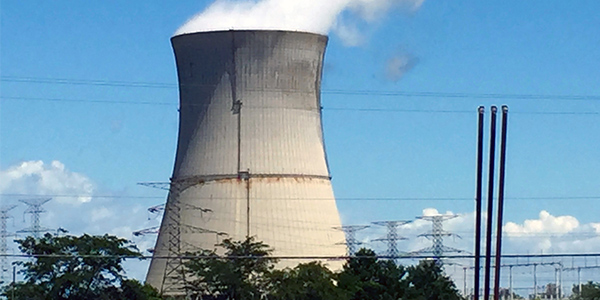By Christen Smith
Ohio legislators approved a controversial bill Tuesday to subsidize FirstEnergy Solutions’ nuclear reactors on Lake Erie, making it the third state to provide a financial lifeline to the nuclear industry in PJM.
The Ohio House of Representatives voted 51-38 in favor of the $170 million Ohio Clean Air Act (HB 6). Republican Gov. Mike DeWine quickly signed the bill later that day, officially curtailing the state’s current renewable portfolio standards and tacking on monthly fees — ranging from 80 cents for residential customers to $2,400 for large industrial plants — to electricity bills for the Davis-Besse and Perry nuclear facilities. Some $20 million of the fees collected will support six solar power projects in rural areas of the state.
Ratepayers will also notice a $1.50 charge to supplement two Ohio Valley Electric Corp. (OVEC) coal plants — a House-crafted addition meant to attract support from electric distribution utilities, according to some critics. (See Ohio Nuke Bill: A Worthwhile Tradeoff?)

Davis-Besse Nuclear Power Plant
“We are very pleased that Gov. Mike DeWine signed HB 6 following its successful bipartisan passage in the General Assembly,” said John W. Judge, CEO of FirstEnergy Solutions. “We’re also thankful for the support and commitment by Speaker [Larry] Householder and Senate President [Larry] Obhof, who understood the importance of protecting 90% of the state’s zero-emissions electricity, substantial employment and the need to provide affordable rates from a diverse portfolio of generation sources for Ohioans.”
Judge confirmed that FES will rescind deactivation orders for both plants and prepare for necessary refueling in the spring.
With DeWine’s signature, Ohio joins New Jersey and Illinois as the only states in PJM to subsidize nuclear generation — a policy reaction to the economic impact of cheap, natural gas-fired generation setting prices in the wholesale markets. Supporters insist the support is justified because the RTO’s market structure doesn’t appropriately value the reliability and carbon-free emissions provided by nuclear power. Without them, proponents say states can’t achieve aggressive clean energy targets because renewables are intermittent. (See Nuclear, Gas Seen as Crucial to PJM’s Renewables Growth.)
Gregory Wetstone, CEO of the American Council on Renewable Energy (ACORE), characterized the plan as a “bailout” — echoing the sentiments of critics in both the clean energy and natural gas sectors who argue the subsidies will distort the wholesale energy market and spike electricity prices.
“At a time when the nation is accelerating its transition to affordable, pollution-free renewable power, this legislation goes in precisely the wrong direction with a bailout of aging and uneconomic coal and nuclear plants and a weakening of the state’s renewable portfolio standard,” he said.
“House Bill 6 is just the latest, though maybe the worst, of the retreats from the legislature’s brave stand for utility consumers through power plant competition in 1999,” said Bruce Weston, counsel for the Ohio Consumers’ Counsel (OCC). “Power companies have too much influence in Ohio, and that should be reformed.”
AARP joined ACORE, the OCC and the Ohio Manufacturers’ Association in calling on the governor to veto the bill, to no avail.
Todd Snitchler, CEO of the Electric Power Supply Association, said the bill “unfairly punishes competitive generators who are the largest power producers in Ohio. This bailout jeopardizes competitors’ investments and risks local tax revenues and jobs in the communities hosting competitive coal and natural gas plants that generate thousands of megawatts for Ohio and the PJM region.
“Passage of yet another nuclear bailout makes it more urgent than ever for the Federal Energy Regulatory Commission to swiftly implement effective measures to protect the integrity of PJM’s energy and capacity markets,” he added.
The House vote came six days after the Senate approved the bill, capping off months of hearings that debated the merits of saving the plants at the expense of RPS goals. (See Ohio Senate Clears Nuke Rescue.) Householder (R) had reportedly worked behind the scenes to secure bipartisan support in his chamber by pushing the fees for OVEC, and slashing the RPS mandates long unpopular among state Republicans.
“We are reducing consumers’ bills, repealing wasteful government mandates and keeping good-paying jobs here in Ohio,” Householder said Tuesday. “This is legislation that makes sense for the ratepayers of Ohio.”
Under the plan, the nuclear charges would sunset in 2027, and the Public Utilities Commission would audit the facilities each year between 2022 and 2026 to determine if the subsidies are still needed — an attempt to placate critics who insist the plants aren’t losing money at all.
The RPS — the law determining how much electricity electric distribution utilities procure from renewable resources — will drop from 12.5% by 2027 to 8.5% until 2025, with no continuation of the mandate thereafter.
Opponents have vowed to seek a referendum opposing the bill on the November 2020 election ballot. ClearView Energy Partners said opponents have 90 days after July 23 to collect the necessary 265,774 signatures needed to get it on the ballot. The success of such a measure depends largely on the way election officials word the referendum, ClearView said.


